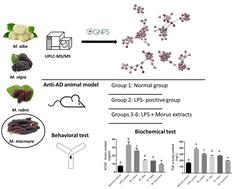当前位置:
X-MOL 学术
›
Food Funct.
›
论文详情
Our official English website, www.x-mol.net, welcomes your feedback! (Note: you will need to create a separate account there.)
Molecular networking-guided investigation of the secondary metabolome of four Morus species and their in vivo neuroprotective potential for the mitigation of Alzheimer's disease
Food & Function ( IF 6.1 ) Pub Date : 2024-03-13 , DOI: 10.1039/d3fo05711a Nesrine M. Hegazi 1 , Tarik A. Mohamed 2 , Abeer Salama 3 , Ahmed R. Hamed 2 , Hamada H. Saad 1, 4 , Ibrahim A. Saleh 2 , Eman H. Reda 5 , Ahmed A. A. Elsayed 6 , Mahmoud A. A. Ibrahim 7, 8 , Paul W. Paré 9 , Thomas Efferth 10 , Mohamed-Elamir F. Hegazy 2
Food & Function ( IF 6.1 ) Pub Date : 2024-03-13 , DOI: 10.1039/d3fo05711a Nesrine M. Hegazi 1 , Tarik A. Mohamed 2 , Abeer Salama 3 , Ahmed R. Hamed 2 , Hamada H. Saad 1, 4 , Ibrahim A. Saleh 2 , Eman H. Reda 5 , Ahmed A. A. Elsayed 6 , Mahmoud A. A. Ibrahim 7, 8 , Paul W. Paré 9 , Thomas Efferth 10 , Mohamed-Elamir F. Hegazy 2
Affiliation

|
Alzheimer's Disease (AD) is a fatal age-related neurodegenerative condition with a multifactorial etiology contributing to 70% of dementia globally. The search for a multi-target agent to hit different targets involved in the pathogenesis of AD is crucial. In the present study, the neuroprotective effects of four Morus extracts were assessed in LPS-induced AD in mice. Among the studied species, M. macroura exhibited a profound effect on alleviating the loss of cognitive function, improved the learning ability, restored the acetylcholine esterase (AChE) levels to normal, and significantly reduced the tumor necrosis factor alpha (TNF-α) brain content in LPS-treated mice. To investigate the secondary metabolome of the studied Morus species, ultra-performance liquid chromatography coupled to tandem mass spectrometry (UPLC-HRMS/MS), aided with feature-based molecular networking, was employed. Among the annotated features, aryl benzofurans and prenylated flavonoids were suggested as being responsible for the observed neuroprotective effect. Furthermore, some of the detected metabolites were proposed as new natural products such as moranoline di-O-hexoside (1), isomers of trimethoxy-dihydrochalcone-O-dihexoside (59 & 76), (hydroxy-dimethoxyphenyl)butenone-O-hexoside (82), and O-methylpreglabridin-O-sulphate (105). In conclusion, our findings advocate the potential usage of M. macroura leaves for the management of AD, yet after considering further clinical trials.
中文翻译:

分子网络引导的四个桑属物种的次级代谢组及其缓解阿尔茨海默病的体内神经保护潜力的研究
阿尔茨海默氏病 (AD) 是一种致命的与年龄相关的神经退行性疾病,其病因是多因素的,导致全球 70% 的痴呆症。寻找多靶点药物来攻击 AD 发病机制中涉及的不同靶点至关重要。在本研究中,评估了四种桑属提取物对 LPS 诱导的 AD 小鼠的神经保护作用。在所研究的物种中,M. macroura在缓解认知功能丧失、提高学习能力、使乙酰胆碱酯酶(AChE)水平恢复正常、显着降低脑肿瘤坏死因子α(TNF-α)方面表现出深远的作用LPS处理小鼠中的含量。为了研究桑属物种的次级代谢组,采用了超高效液相色谱与串联质谱联用 (UPLC-HRMS/MS),并辅以基于特征的分子网络。在注释的特征中,芳基苯并呋喃和异戊二烯化类黄酮被认为是观察到的神经保护作用的原因。此外,一些检测到的代谢物被认为是新的天然产物,例如吗啉二-O-己糖苷( 1 )、三甲氧基-二氢查尔酮-O-二己糖苷的异构体( 59和76 )、(羟基-二甲氧基苯基)丁烯酮-O-己糖苷( 82 )和O-甲基普光甘草定-O-硫酸盐( 105 )。总之,在考虑进一步的临床试验后,我们的研究结果主张大乌拉叶可能用于治疗 AD。
更新日期:2024-03-13
中文翻译:

分子网络引导的四个桑属物种的次级代谢组及其缓解阿尔茨海默病的体内神经保护潜力的研究
阿尔茨海默氏病 (AD) 是一种致命的与年龄相关的神经退行性疾病,其病因是多因素的,导致全球 70% 的痴呆症。寻找多靶点药物来攻击 AD 发病机制中涉及的不同靶点至关重要。在本研究中,评估了四种桑属提取物对 LPS 诱导的 AD 小鼠的神经保护作用。在所研究的物种中,M. macroura在缓解认知功能丧失、提高学习能力、使乙酰胆碱酯酶(AChE)水平恢复正常、显着降低脑肿瘤坏死因子α(TNF-α)方面表现出深远的作用LPS处理小鼠中的含量。为了研究桑属物种的次级代谢组,采用了超高效液相色谱与串联质谱联用 (UPLC-HRMS/MS),并辅以基于特征的分子网络。在注释的特征中,芳基苯并呋喃和异戊二烯化类黄酮被认为是观察到的神经保护作用的原因。此外,一些检测到的代谢物被认为是新的天然产物,例如吗啉二-O-己糖苷( 1 )、三甲氧基-二氢查尔酮-O-二己糖苷的异构体( 59和76 )、(羟基-二甲氧基苯基)丁烯酮-O-己糖苷( 82 )和O-甲基普光甘草定-O-硫酸盐( 105 )。总之,在考虑进一步的临床试验后,我们的研究结果主张大乌拉叶可能用于治疗 AD。



























 京公网安备 11010802027423号
京公网安备 11010802027423号